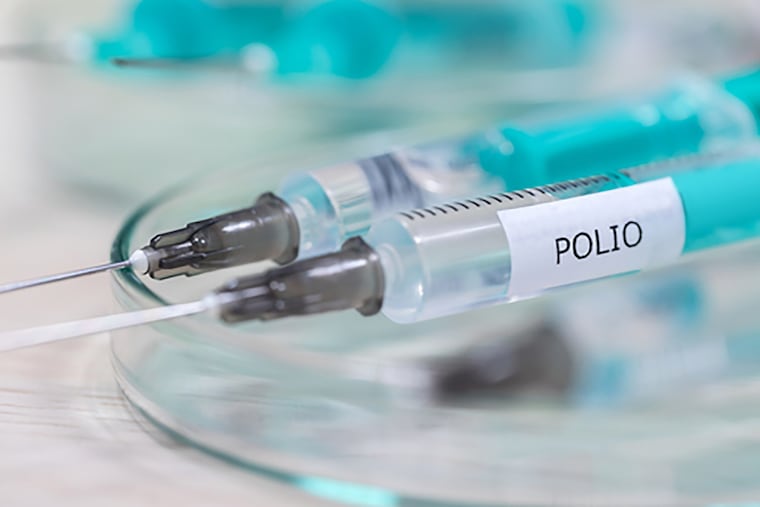Polio has been found in the U.S. Here’s what to know.
Polio was at its peak in the U.S. in the 1940s and '50s, terrorizing parents who watched their children losing the use of their limbs or gasping for oxygen when the virus attacked.

In July, a 20-year-old man from Rockland County, N.Y., was diagnosed with polio, a disabling and potentially deadly disease that had been considered eliminated in the United States. The infected man was unvaccinated and had not traveled overseas during the period when he could have been exposed to the virus, suggesting he contracted it in this country.
Wastewater testing has since shown that the virus is present in nearby New York City, as well as Rockland and neighboring Orange counties. It was also found in the wastewater in London, prompting authorities to offer children ages 1 to 9 a vaccine booster. No cases have been reported there.
Polio was at its peak in the U.S. in the 1940s and '50s, terrorizing parents who watched their children losing the use of their limbs or gasping for oxygen when the virus attacked the muscles of their chests.
Paralytic polio can't be cured, but it can be prevented with safe and effective vaccination; the polio vaccine has been part of the standard schedule of childhood vaccinations for decades.
Here's what you need to know about polio and the polio vaccine.
How contagious is polio?
The poliovirus spreads from person to person very easily. It lives in the throat and intestines and is passed on through contact with feces or, less commonly, through droplets from a cough or sneeze.
Most people don't have any visible symptoms, according to the Centers for Disease Control and Prevention. About 25% develop flu-like symptoms, including headache, fever and nausea. A few get meningitis when the virus attacks the covering of the spinal cord or brain. A smaller percentage end up paralyzed.
People who recover can develop muscle pain or even paralysis decades later, in what is called post-polio syndrome.
How is the polio vaccine given?
There are two vaccines for polio, inactivated vaccine (IPV), given with a shot into either the arm or leg, and oral vaccine (OPV).
Even though the oral vaccine is easier to administer and may give longer-lasting immunity, it has a key disadvantage: In poorly immunized populations, it can occasionally lead to vaccine-derived polio, a strain of which was identified in the unvaccinated Rockland County patient.
Vaccine-derived strains are related to the weakened live poliovirus in the oral vaccine, which can revert to a form that causes illness if it circulates in under-immunized populations or replicates in an immunocompromised person, the CDC says.
"The oral form of the vaccine can change in the body and become pathogenic," said Wafaa El-Sadr, a professor of epidemiology and medicine at Columbia University's Mailman School of Public Health.
Since 2000, the United States has offered only IPV, but OPV is still provided in other countries.
Who should be vaccinated against polio?
Everyone, with very few exceptions.
"If someone had a severe allergic reaction to a prior dose of IPV, or if they are severely ill, a doctor would likely not recommend the vaccination," said Abigail Neel, a research associate at the Johns Hopkins Bloomberg School of Public Health. "But otherwise it's a safe, important tool for protecting against the poliovirus," Neel said.
Unvaccinated adults should get a course of three shots; children get four, including a booster. Side effects of the IPV are minimal, including fever and soreness at the injection site.
The Centers for Disease Control and Prevention recommends children get their first shot at two months with follow-ups at four months, six through 18 months, and a booster at four through six years of age.
Can you get and spread polio after receiving OPV?
Very rarely. The OPV is considered a safe and effective vaccine that has saved countless people from crippling illness and death.
Vaccine-derived strains emerge when the weakened strain of the poliovirus from the oral vaccine spreads through under-immunized populations, as appears to have happened in Rockland County, where many people have not received shots for vaccine-preventable diseases, including polio measles.
While more than 90% of children nationwide have been vaccinated against polio, only about 60% of two-year-olds in the county have received their first three shots, according to health department data. In some Zip codes, the vaccination rate is lower than 40%.
According to the CDC, three previous cases of vaccine-derived polio have been identified in the United States since 2000, all related to people who were either not vaccinated or had a weakened immune systems.
Because vaccine coverage with IPV is high in the United States, the CDC says that vaccine-derived polio is unlikely to become widespread across the country.
If I was vaccinated decades ago, am I still protected?
Yes. Most American adults were vaccinated as children and are likely to be fully protected.
There are few scenarios that put vaccinated people at higher risk, El-Sadr said, including traveling to a high-risk country, working with virus samples in a lab or being a health care worker caring for polio patients.
According to the CDC, fully vaccinated adults who are at increased risk of coming in contact with poliovirus may receive a single IPV booster. The public health agency also recommends that adults who did not complete their vaccinations now get IPV shots.
Public health officials also recommend good hand hygiene and wastewater management to prevent germs like the poliovirus from spreading.
The Rockland County case is a “wake-up call” for people in developed countries like the United States, said El-Sadr. “People think of polio as something that doesn’t happen here,” she said, “but it’s a reminder that we remain vulnerable.”